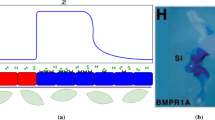Abstract
The problem of cellular differentiation and consequent pattern generation during embryonic development has been mathematically investigated with the help of a reaction-diffusion model. It is by now a well-recognized fact that diffusion of micromolecules (through intercellular gap junctions), which is dependent on the spatial parameter (r), serve the purpose of ‘positional information’ for differentiation. Based on this principle the present model has been constructed by coupling the Goodwin-type equations for RNA and protein synthesis with the diffusion process. The homogeneous Goodwin system can exhibit stable periodic solution if the value of the cooperativity as measured by the Hill coefficient (ρ) is greater than 8, which is not biologically realistic. In the present work it has been observed that inclusion of a negative cross-diffusion can drive the system into local instability for any value of ρ and thus a time-periodic spatial solution is possible around the unstable local equilibrium, eventually leading to a definite pattern formation. Inclusion of a negative cross-diffusion thus makes the system biologically realistic. The cross-diffusion can also give rise to a stationary wave-like dissipative structure.
Similar content being viewed by others
Literature
Auchmuty, J. F. G. and G. Nicolis. 1975. “Bifurcation Analysis of Nonlinear Reaction-Diffusion Equations—I: Evolution Equations and the Steady State Solutions.”Bull. math. Biol. 37, 323–365.
— and —. 1976. “Bifurcation Analysis of Nonlinear Reaction-Diffusion Equations —III: Chemical Oscillations.”Bull. math. Biol. 38, 325–350.
Babloyantz, A. and J. Hiernaux. 1975. “Models for Cell Differentiation and Generation of Polarity in Diffusion Governed Morphogenetic Fields.”Bull. math. Biol. 37, 637–657.
Berding, C. and H. Haken. 1982. “Pattern Formation in Morphogenesis.”J. math. Biol. 14, 133–151.
Boa, J. A. and D. S. Cohen. 1976. “Bifurcations of Localized Disturbances in a Model Biochemical Reaction.”SIAM J. appl. Math. 30, 123–135.
Erneux, T., J. Hiernaux and G. Nicolis. 1978. “Turing's Theory in Morphogenesis.”Bull. math. Biol. 40, 771–789.
Gierer, A. and H. Meinhardt. 1972. “A Theory of Biological Pattern Formation.”Kybernetik 12, 30–39.
— and —. 1974. “Applications of a Theory of Biological Pattern Formation Based on Lateral Inhibition.”J. Cell. Sci.,15, 321–376.
Glass, L. and S. A. Kauffman. 1972. “Co-operative Components, Spatial Localization and Oscillatory Cellular Dynamics.”J. theor. Biol. 34, 219–237.
— and R. Perez. 1974. “Limit Cycle Oscillations in Compartmental Chemical Systems.”J. Chem. Phys. 61, 5242–5239.
Goodwin, B. C. 1963.Temporal Organization in Cells. New York: Academic Press.
—. 1965. “Oscillatory Behaviour in Enzymatic Control Processes.”Adv. Enzyme Regulat. 3, 425–438.
Granero, M. I., A. Porati and D. Zanacca. 1977. “Bifurcation Analysis of Pattern Formation in a Diffusion Governed Morphogenetic Field.”J. math. Biol.,4, 21–27.
Griffith, J. S. 1968. “Mathematics of Cellular Control Process I: Negative Feedback to One Gene.”J. theor. Biol. 20, 202–208.
Haken, H. and H. Olbrich. 1978. “analytical Treatment of Pattern Formation in the Gierer-Meinhardt Model of Morphogenesis.”J. math. Biol. 6, 317–331.
Jorne, J. 1975. “Negative Ionic Cross Diffusion Coefficient in Electrolytic Solution.”J. theor. Biol. 55, 529–532.
— 1977. “The Diffusive Lotka-Volterra Oscillating System.”J. theor. Biol. 65, 133–139.
Lefever, R. and I. Prigogine. 1968. “Symmetry-Breaking Instabilities in Dissipative System—II.”J. chem. Phys. 48, 1695–1700.
Lewis, J., M. W. Slack and L. Wolpert. 1977 “Thresholds in Development.”J. theor. Biol. 65 579–590.
Mahar, T. J. and B. J. Matkawsky. 1977. “A Model Biochemical Reaction Exhibiting Secondary Bifurcation.”SIAM J. appl. Math. 32, 394–404.
Marchbansk, R. M. 1970. “Ion Transport and Metabolism in Brain.” InMembranes and Ion Transport, Vol.2 E. Bittar (Ed.) New York: Wiley.
Martinez, H. M. 1972. “Morphogenesis and Chemical Dissipative Structures: a Computer Simulated Case Study.”J. theor. Biol. 36, 479–501.
Murray, J. D. 1977.Lectures on Nonlinear-Differential-Equation Models in Biology. Oxford: Oxford University Press.
Nakamura, R. 1963. “The Transport of Histidine and Methionine in Rat Brain Slices.”J. Biochem. 53, 314–332.
Nicolis, G. and J. F. G. Auchmuty. 1974. “Dissipative Structure, Catastrophes and Pattern Formation: a Bifurcation Analysis.”Proc. natn. Acad. Sci. U.S.A.,71, 2748–2751.
Nicolis, G. and I. Prigogine. 1977.Self Organization in Non-Equilibrium Systems. New York: Wiley.
Othmer, H. C. 1977. “Current Theories of Pattern Formation.” InLectures on Mathematics in Life Sciences, S. Levin (Ed.), Vol.9, pp. 55–86. American: Mathematical Association.
— and L. E. Scriven. 1971. “Instability and Dynamic Pattern in Cellular Networks.”J. theor. Biol. 32, 507–537.
Rapp, P. E. 1975a. “Biochemical Oscillators—a Search Procedure.”Mathl Biosci. 23, 289–303.
— 1975b. “A Theoretical Investigation of a Large Class of Biochemical Oscillators.”Mathl Biosci. 25, 165–188.
— 1976. “Mathematical Techniques for the Study of Oscillations in Biochemical Control Loops.”Bull. Inst. Math. Applics. 12, 11–21.
Tapaswi, P. K. 1982. “Time Lags in an Extended Mathematical Model of Transcription and Translation During Embryogenesis.”Cybernetica 25, 151–162.
— and P. Bhattacharya. 1981. “An Extended Mathematical Model of Transcription and Translation during Embryogenesis.”Cybernetica 24, 61–84.
Turing, A. M. 1952. “The Chemical Basis of Morpogenesis.”Phil. Trans. R. Soc. B237, 37–72.
Tyson, J. J. 1975. “On the Existence of Oscillatory Solutions in Negative Feedback Cellular Control Processes.”J. math. Biol. 1, 311–315.
— and H. G. Othmer. 1977. “The Dynamics of Feedback Control Circuits in Biochemical Pathways.” InProgress of Theoretical Biology, Vol. 5. New York: Academic Press.
Volkenshtein, M. V. 1983.Biophysics. Moscow: MIR Publishers.
Waddington, C. H. 1956.Principles of Embryology. London: George Allen & Unwin.
Walter, C. F. 1970. “The Occurrence and Significance of Limit Cycle Behaviour in Controlled Biochemical Systems.”J. theor. Biol. 27, 259–272.
Wolpert, L. 1969. “Positional Information and the Spatial Pattern of Cellular Differentiation.”J. theor. Biol. 25, 1–47.
Author information
Authors and Affiliations
Rights and permissions
About this article
Cite this article
Tapaswi, P.K., Saha, A.K. Pattern formation and morphogenesis: A reaction-diffusion model. Bltn Mathcal Biology 48, 213–228 (1986). https://doi.org/10.1007/BF02460024
Received:
Revised:
Issue Date:
DOI: https://doi.org/10.1007/BF02460024




